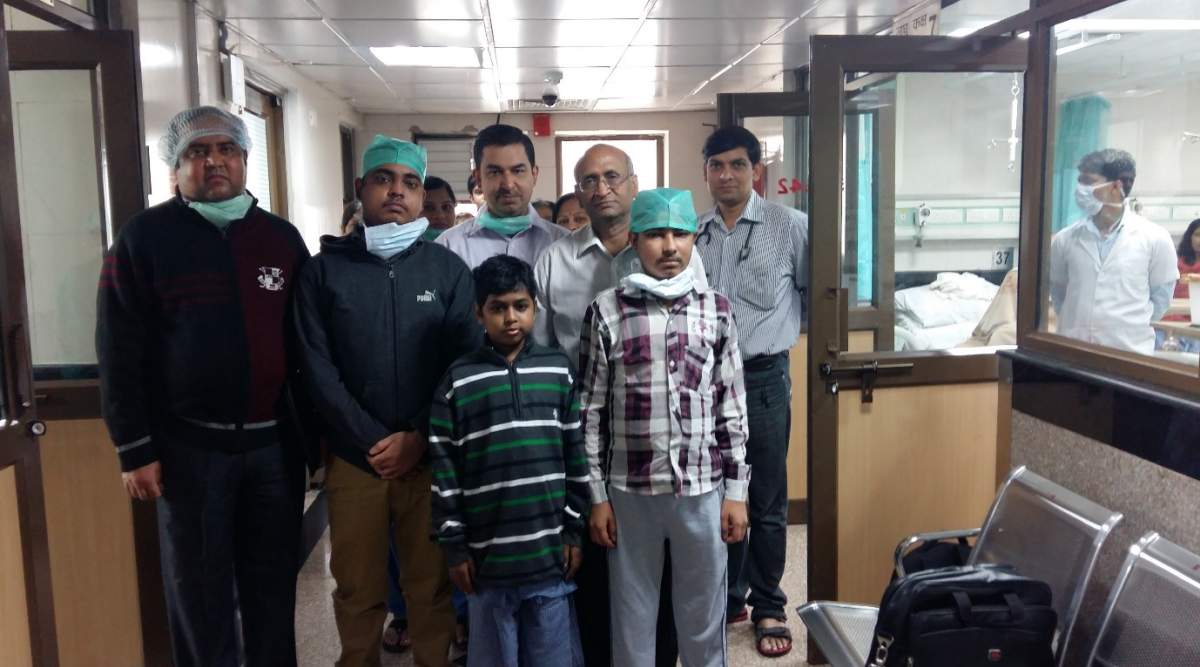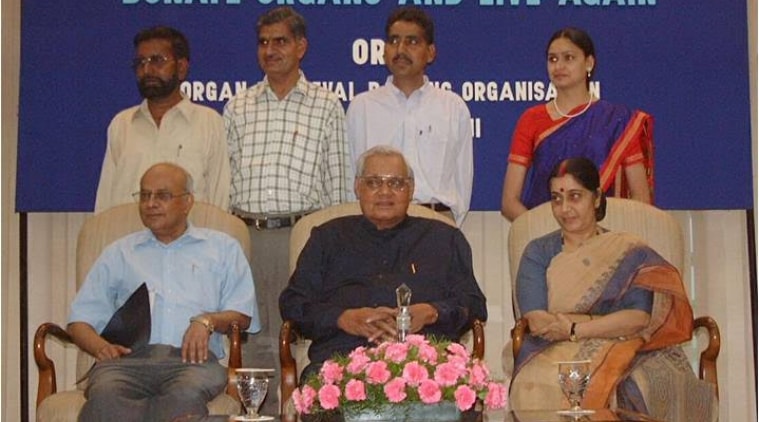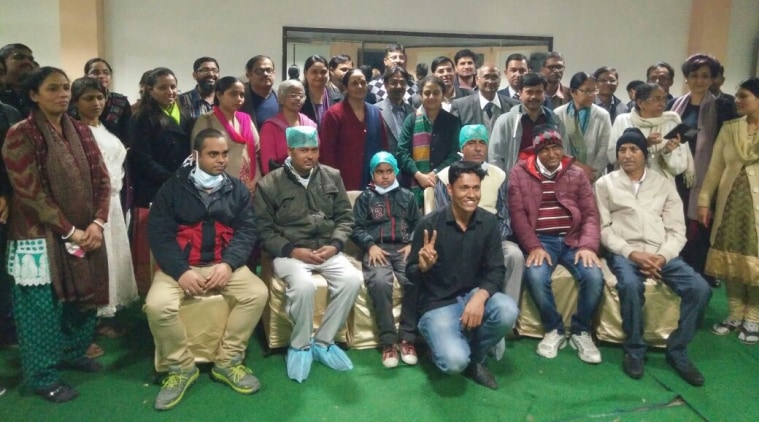 It’s a big Team: the Patients with the doctors and the Team (cardiologists, surgeons, nurses , transplant coordinators and many others)
It’s a big Team: the Patients with the doctors and the Team (cardiologists, surgeons, nurses , transplant coordinators and many others) It was on a visit to Mount Sinai Medical Centre in New York in 2006 that I was sitting with Dr Alan Gass, a transplant cardiologist, discussing one of my young patients who had had a heart transplant in 2001 at AIIMS. When I mentioned the year, he immediately took out a yellowed newspaper cutting. It said that bhajan singer Anup Jalota’s young wife, Medha, had had a heart transplant at Mount Sinai the same year as my patient – only Medha had travelled all the way from India to the US to get it. My patient got it much closer to home.
Both Medha and my patient are success stories in the world of heart transplantation. Medha went on to live happily for a decade after her transplant. My patient, who came to AIIMS with advanced heart failure but is still doing well 21 years after her transplant, was seen by the team led by Dr P Venugopal – the same man who did India’s first successful heart transplant in 1994.
But the story of the heart transplant in India is much older…
The beginning
“ln these years later I can still see it clearly. It was an unforgettable sight. We had taken the old heart and we needed to move damn fast to fill that huge hole with a new heart. No wonder they were frightened of us then. No wonder they thought we were out of our minds.”
Subscriber Only Stories
—–Adrian Kantrowitz (American Transplant Surgeon)
In 1967, the race was on for a successful heart transplant in the world: the surgical teams in the US were led by Dr Norman Shumway in Stanford, Dr Richard Lower in Virginia and Dr Adrian Kantrowitz in New York. But the winner was a relatively unknown contender from another country entirely, Dr Christiaan Barnard from South Africa, who performed the first successful human-to-human heart transplant at the Groote Schuur Hospital, Cape Town on the night of 2/3 December 1967.
 A vintage picture : Dr P Venugopal with Prime Minister AB Vajpayee, the Health Minister Sushma Swaraj, the first transplant patient Devi Ram standing on the left, along with three of the early patients.
A vintage picture : Dr P Venugopal with Prime Minister AB Vajpayee, the Health Minister Sushma Swaraj, the first transplant patient Devi Ram standing on the left, along with three of the early patients. India was not far behind. Dr PK Sen in Mumbai had been preparing for heart transplant by practising on dogs. In February 1968, he did a heart transplant, the first for India and the fourth in the world. Unfortunately, that patient died, and so did the next one, and India’s heart transplant programme did not take off.
But it was only 26 years later that the team at AIIMS led by Dr P Venugopal did the first successful heart transplant on August 3 1994. The patient was Devi Ram, a 40-year-old heavy industry worker. The donor of the heart was a 35-year-old woman who had died of brain haemorrhage just across the corridor in the neurosurgery ward.
The stress on the team was palpable. The first ever transplant patient by Dr Christiaan Barnard had lived only for 18 days. Both of PK Sen’s patients had died. In Dr Venugopal’s words, “We were confident and prepared. The surgery was planned well and properly executed. But we also knew that an unsuccessful transplant would’ve meant destroying the procedure for 20 years.”
The surgery was successful, and the patient lived on for more than a decade, dying later of a brain tumour.
AIIMS has since done more than 80 heart transplants (the highest number in the government sector) and also recently started the lung transplant program with two successful transplants.
The Gift of Life
“We ourselves feel that what we are doing is just a drop in the ocean. But if that drop was not in the ocean, I think the ocean would be less because of that missing drop.” — Mother Teresa
Heart transplant is an expensive therapy and not everyone gets a heart but the story of each heart transplant inspires us to do more.
The Engineer: Animesh (name changed for privacy) was a young boy preparing for IIT when he developed sudden heart failure. We were unable to manage him with medicines and had listed him for an urgent heart transplant. These were years when only one to two transplants were being done at most centres.
While waiting for a heart, he had a cardiac arrest and we had to do a cardiac massage and put him on a heart lung machine. A nation-wide alert was issued for a heart. His blood group was AB positive (a universal recipient blood group). A heart became available in Jaipur, our surgeon flew overnight to Jaipur, harvested the heart, flew back and transplanted the heart. Animesh recovered, and is today finishing his fourth year in mechanical engineering.
 Heart transplant patients with the team of doctors, cardiologists, and staff.
Heart transplant patients with the team of doctors, cardiologists, and staff. A Marriage: Ruksana (name changed) is another young lady, one of five girls in a family where three girls have heart failure. She was listed for heart transplant but had no money. In fact, she had to pay for her medicines by teaching in a local madrassa. She was helped by a Rs 10-lakh grant by the Health Ministry and underwent a heart transplant. Today, three years later, she is married and planning a family.
Blue to Pink: Krishna (name changed) was born as a blue baby with a complex cardiac problem. After birth, he underwent multiple surgeries till finally at the age of 20, the surgeons gave up and said that no more surgeries were possible. He was sent for a heart transplant. He waiting for more than one year and we could only keep encouraging him and supporting him with the hope that he would get a heart. At last, the wait was over after more than a year, and after a difficult surgery, he recovered and is now a successful executive in a travel company.
Step-by-step: How does a heart transplant happen?
There are two sides to the story. The Patient who needs the heart transplant and the Donor Family who gives a heart. The patient is one with advanced heart failure who has exhausted all forms of therapy, and goes to a transplant centre. There, he is evaluated in detail for any correctable or treatable cause and is finally listed with NOTTO, which is the central government agency regulating heart transplant in India. Backing the patient is a team of cardiologists, cardiac surgeons, intensivists, nurses, transplant coordinators and social workers.
When another patient undergoes declaration of Brain Death, often at a trauma hospital or a neurosurgery ward, social workers or doctors talk to the family and counsel them regarding organ donation. If the family is willing, a coordinated teamwork begins.
All teams which can harvest a healthy organ (heart, lung, liver, kidney, eyes) are informed and assess the patient and alert the organ’s recipients. If the organs are acceptable, the recipient is called in to the hospital.
Usually, one team will start harvesting the organ and another team will get the recipient ready. If the organ harvesting is from another city, then the local police, green corridors and air transport all come together to get the harvested organ to the patient within four hours.
The moment the organ reaches the recipient hospital, the surgery takes place and can take anywhere from 4 to 10 hours depending on the organ and complexity. The patient is usually in the ICU for 2-3 days and discharged at about 2-3 weeks.
The Myths.
Organ Donation:
I have too many diseases to be an organ donor: Even patients with diabetes, hypertension, hepatitis can donate organs.
If there is a consent for organ donation, the doctors will not work hard to save a life: Doctors are trained to save lives. They will never compromise on this. It’s only after brain death is declared that organ donation is considered.
I am too old for organ donation: There is no age limit for organ donation.
It is against my religion: No religion is against organ donation. If in doubt, talk to your religious leader.
Transplanted Patient:
Cannot Lead a normal life: Except for the need for lifelong medication, patients can lead normal lives as illustrated in some of the above stories.
The Heart does not last long: The longest survivors have lived for more than 33 years after a transplant. There is always an option of a second transplant. In India itself, Reena Raju, who is a famous national level hockey player, underwent a second heart transplant when the first heart transplant failed after eight years.
India today: The transplant story continues.
After the first successful heart transplant in 1994, a number of centres in India gradually started doing transplants but in the next five years only about 50 transplants took place. This was mainly due to the lack of an organised organ donation programme, reluctance on the part of the public to accept the concept of organ donation (especially at the time of brain death) and a lack of government priorities towards this very expensive form of therapy.
Slowly the programme picked up with State and Central governments recognising and supporting the programme, and a more organised organ donation programme began in many states and awareness of the concept of organ donation increased. Today India has done more than 1500 heart transplants, with now more than 200 done annually.
The Road Ahead
Patients who have advanced heart failure can only be saved by a heart transplant. The transplant is expensive – not only is the surgery expensive but the post-surgery medicines cost up to Rs 60,000 a month for almost three to six months before the cost comes down.
The surgery itself is at a cost of Rs 15-20 lakh. Government hospitals cost less (AIIMS does transplants at a cost of Rs 15 lakhs which includes all medicines for a period of 2 years). Government support for the transplant programme is gradually becoming available but more needs to be done. Organ donation awareness also is important.
Who can donate?
Anyone can pledge to be an organ donor. You can fill an online pledge form on https://notto.gov.in. This registration is just an expression of your intent to be an organ donor. You get a donor card and you should share your wishes with your next of kin because as per law, the final decision for organ donation has to be taken by the next of kin.
- The Indian Express website has been rated GREEN for its credibility and trustworthiness by Newsguard, a global service that rates news sources for their journalistic standards.

